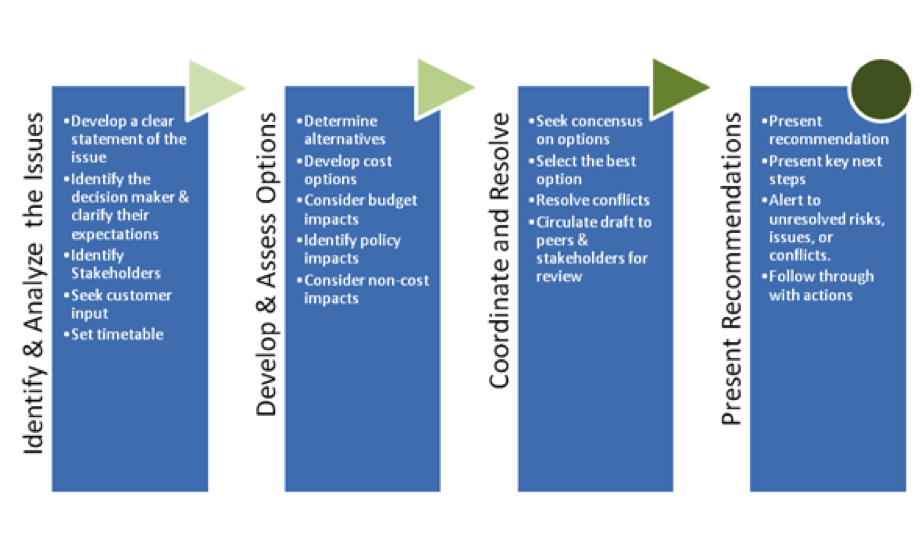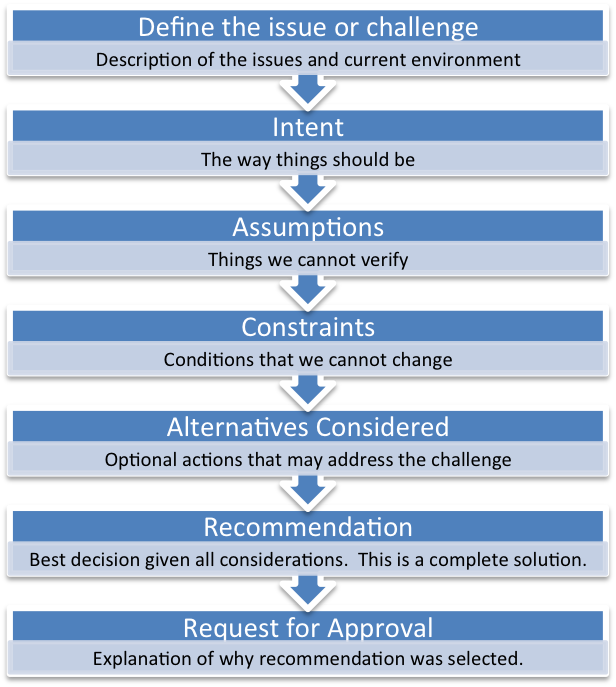Revisiting the Doctrine of Completed Staff Work
In my particular case, we were not at war, per se, but I guess my boss was equally frustrated with the amount of additional research and rework that was needed in order for him to make a confident decision. The article was a subtle way of educating the staff into a change in behavior. Unfortunately, the article never sat well with me. Instead of the intended effect, it only served as a reminder of the formal power relationship between a supervisor and subordinate. The challenges we faced were too big for any one of us to handle so we naturally faced them as a team. To suddenly be reminded of my place in the organization was not the kind of empowerment I become accustomed to and I was left feeling that the doctrine was severely out of touch with our reality. But as I reflect back on the experience, I wonder if we can recast the principles of this forlong doctrine to teach the trained initiative that is highly regarded but apply it to today’s team- oriented atmosphere.
Let’s start with the basic premise that a) everyone is busy, b) resources are tight and c) our team trusts us because of our knowledge, experience, and expertise. We were hired to shoulder the responsibilities expected of our position. Even if the decision- making authority formally resides somewhere else on the team, that person or group is relying on us to provide a recommendation for how to proceed as if it were our decision to make. To present a recommendation, the following objectives must first be met:
-
-
- The issues are clearly articulated in a fair, balanced way.
- Issues are thoroughly analyzed including internal and external influences.
- Several alternatives have been considered.
- The solution is complete. It accounts for resources, staffing, time, & risk.
- The recommendation has been coordinated with stakeholders.
- The final product is prepared in final form for signature and requires simple approval.
-
The figure below outlines a process for meeting these objectives in a logical framework. If we expect someone to make a decision, this format helps them understand the full context, complexity, and impact of the decision at hand.

If this process is followed, the goal for the final presentation is to formally walk the decision-maker through the thought process. We are well-equipped to respond to leadership questions and concerns and with practice will learn about the dominant issues facing leadership. Over time, team trust is enhanced as the decision-maker understands the rigor applied to recommendations in this format. The table below can be used to format the recommendation whether through a presentation, white paper, or even a verbal briefing.

This approach contributes to the professional development of junior staff members, as well. It opens an opportunity to understand the context and consequences (both intended and not) of challenges faced by the leadership team. Additionally, it provides unique access to different thought processes of experienced decision-makers – how they weigh various factors, how they perceive the environment, and how they rationalize their decision. Working through solutions in this manner exposes us to the senior leadership thinking that most professionals aspire to and is a great way to demonstrate that ability to the leadership team. There is no better evidence of problem-solving than real decisions applied to challenges faced by the organization.
NOTE: The full Completed Staff Work doctrine is presented below. As you read it, don’t let the tone of the memo distract you from the real lessons in leadership that are presented. The following memorandum has been reproduced countless times by military and civilian organizations since World War II. The original source of the memorandum is unclear. Some reports indicate that the memo was issued in January 1942 by the Provost Marshal General, U.S. Army. It has also been attributed to Brigadier G.E.R. Smith, a member of the Royal Canadian Army, who released it in 1943, while he was serving as Deputy Director of Supplies and Transport, First Canadian Army. It can be found here.
SUBJECT: Completed Staff Work
The doctrine of “completed staff work” will be the doctrine of this office.
- “Completed Staff Work” is the study of a problem, and presentation of a solution, by a staff officer, in such form that all that remains to be done on the part of the head of the staff division, or the commander, is to indicate his approval or disapproval of the completed action. The words “completed staff action” are emphasized because the more difficult the problem is the more the tendency is to present the problem to the chief in piecemeal fashion. It is your duty as a staff officer to work out the details. You should not consult your chief in the determination of those details, no matter how perplexing they may be. You may and should consult other staff officers. The product, whether it involves the pronouncement of a new policy or affect an established one, should when presented to the chief for approval or disapproval, be worked out in finished form.
- The impulse which often comes to the inexperienced staff officer to ask the chief what to do, recurs more often when the problem is difficult. It is accompanied by a feeling of mental frustration. It is so easy to ask the chief what to do, and it appears so easy if you do not know your job. It is your job to advise your chief what he ought to do, not to ask him what you ought to do. He needs your answers, not questions. Your job is to study, write, restudy and rewrite until you have evolved a single proposed action – the best one of all you have considered. Your chief merely approves or disapproves.
- Do not worry your chief with long explanations and memoranda. Writing a memorandum to your chief does not constitute completed staff work, but writing a memorandum for your chief to send to someone else does. Your view should be placed before him in finished form so that he can make them his views by simply signing his name. In most instances, completed staff work results in a single document prepared for the signature of the chief, without accompanying comment. If the proper result is reached, the chief will usually recognize it at once. If he wants comment or explanation, he will ask for it.
- The theory of completed staff work does not preclude a “rough draft”, but the rough draft must not be a half-baked idea. It must be completed in every respect except that it lacks the requisite number of copies and need not be neat. But a rough draft must not be used as an excuse for shifting to the chief the burden of formulating the action.
- The “completed staff work” theory may result in more work for the staff officer, but it results in more freedom for the chief. This is as it should be. Further, it accomplishes two things:
-
- The chief is protected from half-baked ideas, voluminous memoranda, and immature oral presentations.
- The staff officer who has a real idea to sell is enabled to more readily to find a market.
-
- When you have finished your “completed staff work” the final test is this: If you were the chief would you be willing to sign the paper you have prepared, and stake your professional reputation on its being right? If the answer is negative, take it back and work it over because it is not yet “completed staff work”



